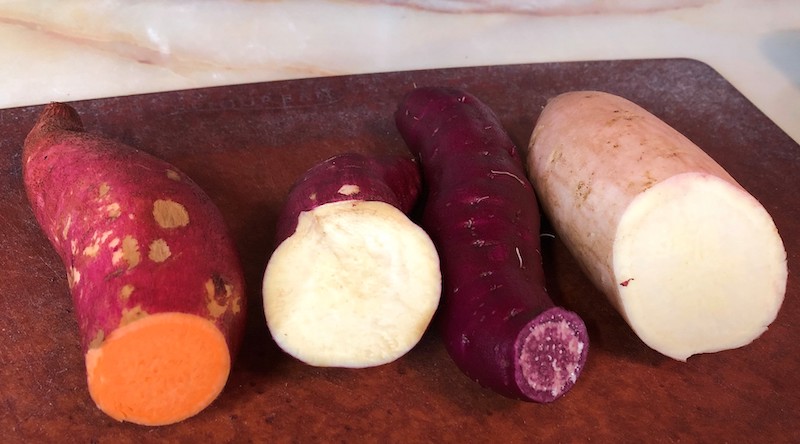One of the things I appreciate most about food gardening is the history, geography and culture that can be discovered through the plants we choose to cultivate. When I finished college, I spent three years as a Peace Corps volunteer on the small, remote island of Ambae in Vanuatu in the South Pacific. Their staple crops — taro, yams, cassava and starchy bananas — took some getting used to for me. But their “kumala,” or sweet potato, was a welcome reminder of home.
The sweet potato (Ipomoea batatas), which is in the morning glory family of plants, is believed to have originated in Central or South America at least 5,000 years ago. Christopher Columbus observed native peoples in Central America and the Caribbean growing the crop and enjoyed them so much that he took some back to Europe on his fourth and final voyage.
The famous explorer Hernando de Soto noted Native Americans growing sweet potatoes in his records from the 1500s. Sweet potatoes were likely one of the first staples early colonists were introduced to in the Southern colonies. It is unlikely, however, that they were on the menu at Plymouth because they require a long, warm growing season that limits their growing range.
The presence of sweet potatoes in the South Pacific predates my time there, with some studies indicating cultivation as early as 1200 A.D. How they arrived there is truly one of the greatest mysteries in human history. There is relative consensus among anthropologists that the migration of Austronesian peoples — which includes the three primary ethnic groups of Micronesian, Melanesian and Polynesian — happened in an eastward direction. The expert navigators used outrigger-type sailing canoes and their mastery of currents, wind patterns and the stars to travel from Taiwan and Southeast Asia through the larger islands of Indonesia and New Guinea to the remote outposts of Hawaii, New Zealand and Easter Island.
If the people came from west to east, how did the sweet potato travel east to west from South America? This was what legendary Norwegian adventurer and ethnographer Thor Heyerdahl set out to prove with his Kon-Tiki expedition in 1947. Heyerdahl’s theory is that Polynesia was populated via South America. He based this theory on Incan legends merged with a Dutch explorer’s journal from the 1700s, the westward movement of the trade winds, and the presence of sweet potatoes throughout the Pacific. To prove his theory, Heyerdahl and five adventurers set off from Peru on a raft made from balsa wood and native materials and washed up on a reef in French Polynesia after 101 days and 4,300 nautical miles. Despite completing the voyage, his theory of Polynesian origin has been widely criticized and has not gained acceptance within the academic community. So the mystery of the Pacific sweet potato remains.
Incan legends and Norwegian adventurers aside, sweet potatoes are an easy-to-grow addition to Georgia gardens. I was a little adventurous in the garden this year and ignored the standard varieties like ‘Beauregard’ and ‘Georgia Jet’. As reliable and tasty as those varieties are, I was looking for more color and variety. Instead I grew ‘Bonita’, which has a light tan skin and white flesh and produces high yields of medium to large roots. ‘Murasaki’ is a purple-skinned, white-flesh variety that has a distinctive nutty flavor. I found ‘Murasaki’ interesting enough but will probably need to give it another year with better growing conditions before deciding its fate in future gardens. I tried a purple-skinned and -fleshed variety but with lower yields of long narrow roots. I will probably pass on it in the future. I also tried ‘Burgundy’, which has a nice, burgundy-colored skin and deep orange flesh similar to ‘Beauregard’.
Maybe your discussions over the sweet potato side dishes this holiday season will solve the mystery of how the sweet potato made it to the Pacific. To learn more about growing sweet potatoes in a home garden, see University of Georgia Cooperative Extension Circular 1014, “Home Garden Sweet Potatoes,” at www.extension.uga.edu/publications.




